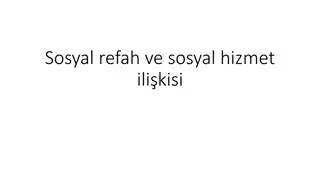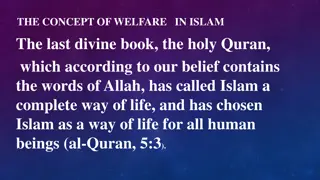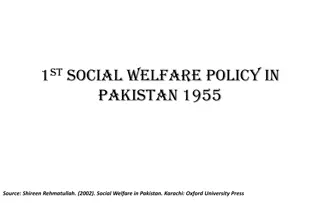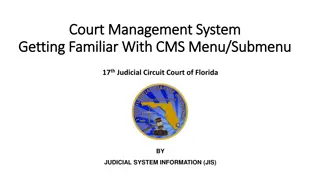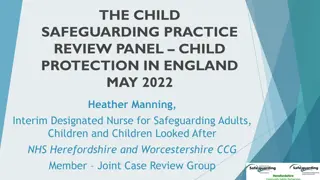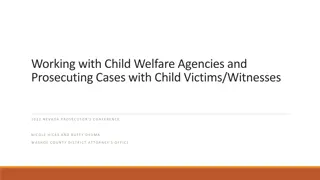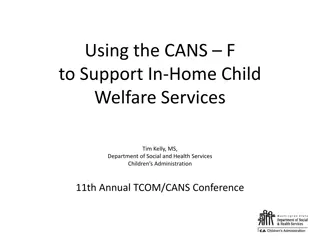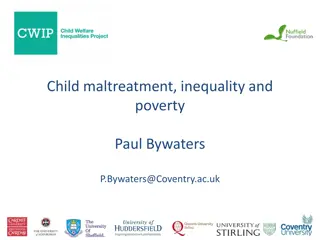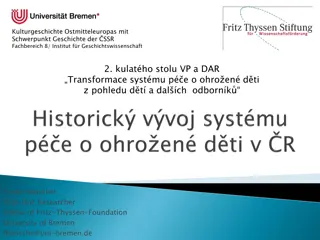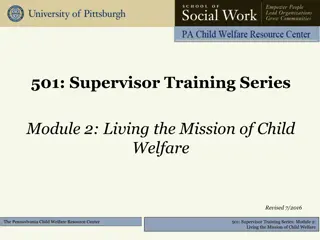Improving Child Welfare Court Practices: A Comprehensive Overview
Explore the policies and considerations related to child welfare court proceedings. Learn about the importance of involving children and families in decision-making processes, as highlighted in reports and guidelines. Understand the rights of children in juvenile court hearings and the benefits of their active participation in court proceedings.
Download Presentation

Please find below an Image/Link to download the presentation.
The content on the website is provided AS IS for your information and personal use only. It may not be sold, licensed, or shared on other websites without obtaining consent from the author. Download presentation by click this link. If you encounter any issues during the download, it is possible that the publisher has removed the file from their server.
E N D
Presentation Transcript
A CHILDS DAY IN COURT
Juvenile Court Child Court
Judge Parent & Counsel Guardian ad Litem Child DCFS & Counsel
Overview: Policy Considerations Relevant Law The benefits The Drawbacks Improving the experience What the children are saying
Policy Considerations: The National Council of Juvenile and Family Court Judges published Resource Guidelines: Improving Court Practice in Child Abuse and Neglect Cases in 1995. These Resource Guidelines, which were endorsed by the American Bar Association (ABA) and the Conference of Chief Justices, which state who should and may be present during each major type of hearing in a child welfare cases, including the age appropriate children who can provide the court with information as to their perception of their needs, interests and concerns.
Cont. One of the guiding principles of the 2004 nonpartisan Pew Commission report, Fostering the Future: Safety, Permanence and Well-Being for Children in Foster Care, was that children and their families must have an informed voice in decisions that are made about their lives. Recommendations from the report included that courts be organized to enable children and parents to participate in meaningful ways in the court process, noting that children, parents and caregivers all benefit when they have the opportunity to actively participate in court proceedings, as does the quality of decisions when judges can see and hear from key parties. Currently, there are 2,842 children in foster care in the state of Utah. The average age is 10.1 years.
78A-6-317, Persons Entitled To Be Present (1) A child who is the subject of a juvenile court hearing is: (a) entitled to notice of the hearing. (2) The child has a right to be present at each hearing, subject to the discretion of the guardian ad Litem or the court regarding any possible detriment to the child. Infers an element of loss or harm
78A-6-305: (2) A child shall be present at any postadjucation (disposition, permanency, review) hearing in a case relating to the abuse, neglect or dependency of the child, unless the court determines that: (a) requiring the child to be present at the hearing would be detrimental to the child or impractical; or (b) the child is not sufficiently mature to articulate the child s wishes in relation to the hearing.
78A-6-305 continued (4)(a) (assuming no detriment or maturity issues) when a child is present at the hearing, the court shall: (i) ask the child if they would like an opportunity to address the court or testify; and (ii) if yes, allow the child to address the court or testify.
78A-6-306, Shelter Hearing: (4) The following persons shall be present at the shelter hearing: (a) the child unless it would be detrimental for the child. (5) (a) At the shelter hearing, the court shall: (ii) subject to Section 78A-6-305, provide an opportunity for the child to testify. Notice, the impractical language is removed
The Benefits: Therapeutic justice: The concept of the law as a therapeutic agent with an emphasis on providing a voice and validation. Allowing the hearing to be a tool for emotional healing. Research in the area of procedural justice suggests that people are able to recognize the fairness of procedures even when they disagree with the actual outcome. Erik S. Pitchal ,Where are the children, UC Davis Journal of Juvenile Law & Policy Vol. 12:1 Participation in a hearing can be an opportunity to ward off feelings of fear and helplessness by providing a sense of control. The foster care system, which can include multiple placements, changing case workers, therapists, and schools, often times without notice, can be very disempowering to a child. Involvement in the process returns a sense of dignity to the child.
Cont. Courts (and stakeholders) make more informed decisions resulting in better outcomes when children participate. Questions such as: What a placement is like; a child s activities, hobbies, interests; whether a child s career goals are being nurtured; educational, mental, physical health, family visits/contact, etc., are all questions that can only be partially provided if a child is not present to contribute. Judges have an opportunity to assess behavior, demeanor, a child s interactions with others in the courtroom, emotional or physical state of the child including growth.
Cont. Having a child present in the court room brings the file to life, regardless of the age of the child. A child s needs become the focus of the hearing and become individualized. Children who spend a substantial amount of time in foster care have far worse outcomes as adults with respect to education, housing, income. Perhaps the quality of the decisions made at critical times in a child s life would result in better outcomes if the child is far more visible in the process.
The Drawbacks: Hearing may be too emotional charged and might further traumatize the youth. This is a valid concern, hearings can be adversarial, participants may be aggressive. Hearings disrupt a child s routine. School, activities, may be interfered with, travel time can be at a great distance. [i]t s incredible to me that we so long believed that the greater good was keeping children-even teenagers-out of court, so that they wouldn t miss school or be exposed to a trauma. What greater trauma could there be than cataclysmic change in their lives without their knowledge. Chief Judge Judith Kaye of New York, as quoted in Family Court Review, Vol. 46 No. 1, January 2008 163-179 High case loads make it difficult to allocate sufficient time for a child to be heard. These cases take longer.
Improving the Experience: Diligently adhere to the statutory requirements (notice, formal versus informal review non appearance, inquire as to absence/detriment on the record or by motion). Lead with the child. Avoid full exclusion from proceedings when possible bifurcate. Set the hearing date well before hand so that transportation can be arranged. Order transportation if necessary. Set the hearing at a convenient time if possible. Be ware of special events that may conflict or that can be recognized at the hearing. Allow the child to appear in chambers when possible or to put their thoughts in writing.
Improving the experience continued. The Guardian ad Litem can prepare the child before hand, debrief after with a therapist if needed. Use youth friendly, jargon free language. Have a safe comfortable space for waiting. Ask for updated pictures of the child when appearance isn t possible. Look at alternatives to complete non appearance such as telephonic hearings or webcam technology.
What the children are saying: Of the 19 children that were questioned, all but 3 said they preferred to attend court. 2 stated that sometimes they want to attend and sometimes they don t. It really depends on what other things are going on in their lives at the time. Only 1 youth stated that he d prefer to appear by telephone. None of the children preferred no participation. 18 year old female, 10 hour trip. I d rather appear because I can get a feel for others expressions. When I see facial expressions, I can understand better, I can see what others want me to work on and I can express myself better. 13 year old male, 9 hour trip. I would rather travel. I like to watch movies in the car and visit my mom. 17 year old male, 9 hour trip. I d rather travel because I can be more honest about how I am doing if I have to look the judge in the eyes.
Cont. 15 year old male, 7 hour trip, I like to travel because I get to hear good things about me and hear the stuff I still have to work on. 11 year old male, 10 hour trip. I like to come to court. It s easier to talk face to face. I get to see people and my mom. 18 year old male, 8 hour trip. I like to travel so I can see my mom and see the horse head on the mountain. It makes me want to work hard so I can come home. 17 year old male, 9 hour trip. I prefer to come to court because I want to be able to hear what was said about me, and for others to hear what I have to say. I don t want to be told by other people what was said. I want to be here personally.
Conclusion Second hand information is rarely a good substitute for a firsthand account. Listening to a child offers a valuable perspective on every decision that a judge, caseworker, Guardian ad Litem, attorney, or parent need to consider. The child can take you into his day-to-day life, what s going well at home and what s not, how he is doing at school, and what kind of permanent living situation he desires and how best to get there.
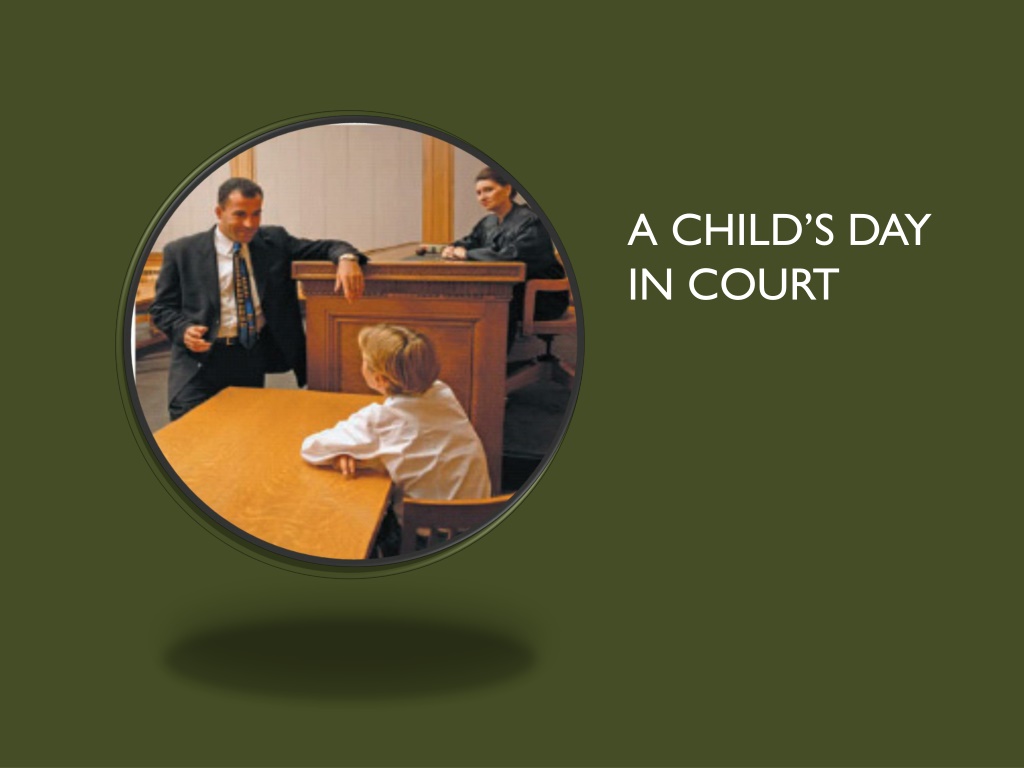
 undefined
undefined






